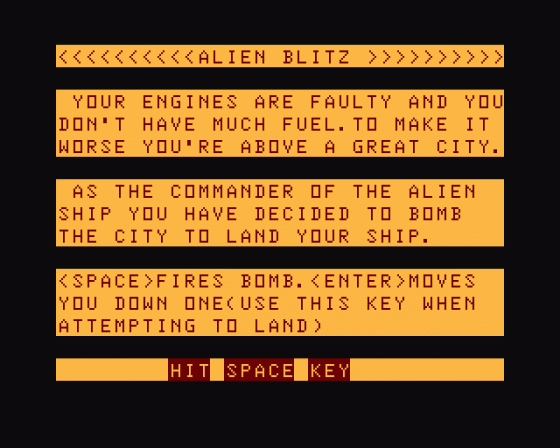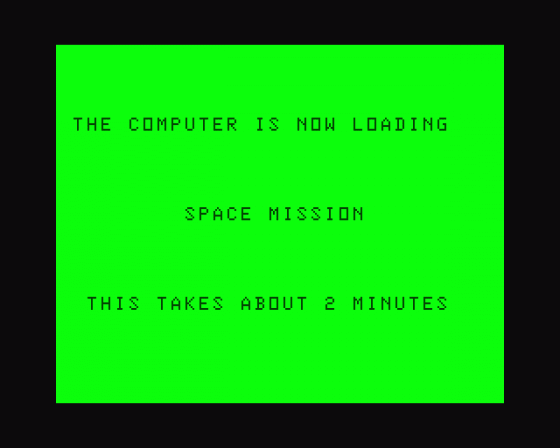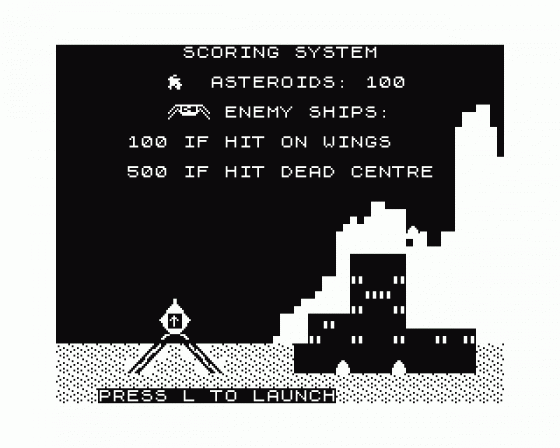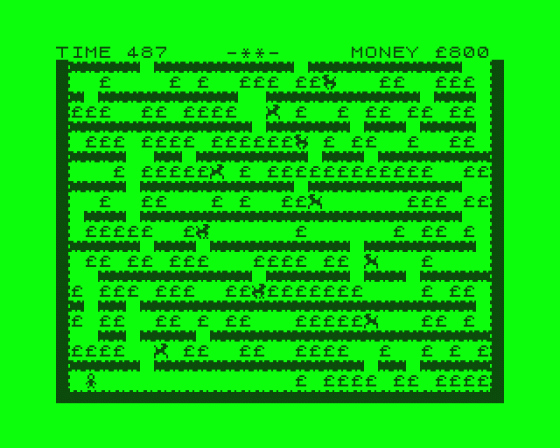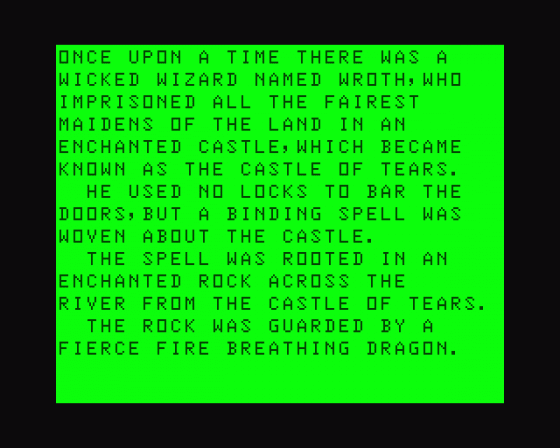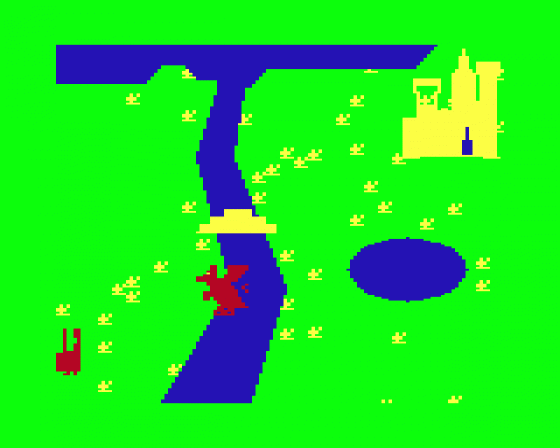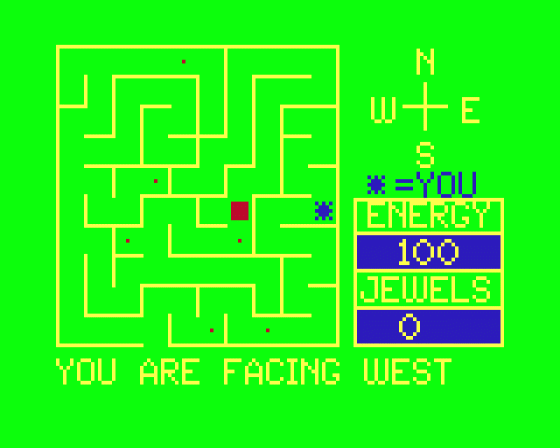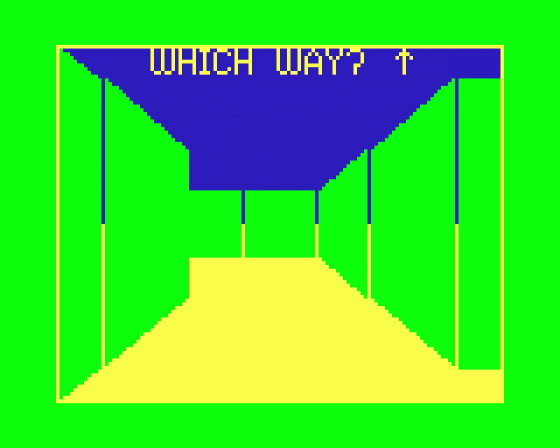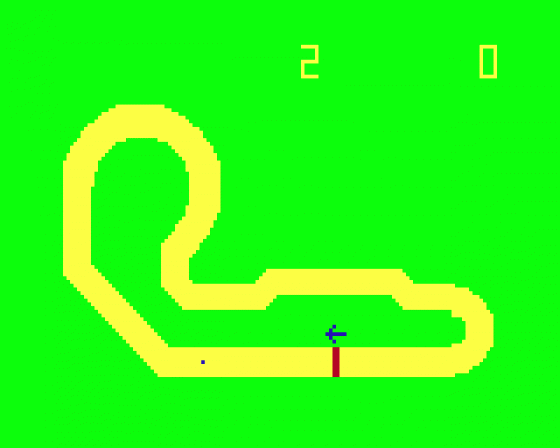
Dragon User
 1st June 1983
1st June 1983
Categories: Review: Software
Author: John Scriven
Publisher: Salamander
Machine: Dragon 32
Published in Dragon User #002
John Scriven tests his hand-eye co-ordination on some arcade-type action games - and finds some winners
Arcade-Action Software Releases
This batch of recent software for the Dragon shows considerable variation, both in content and in quality. Many new software houses are advertising each month, and with such variety it is sometimes difficult to see the wood for the trees. Games can often be divided into two camps: 'skill' games that involve fast hand-eye co-ordination, and 'brain' games that involve careful, logical thought - although better games certainly involve both types of ability. This month I shall be looking at the first category which includes mainly arcade-type action games.
Alien Blitz (Gem Software)
Alien Blitz from Gem Software, at £7.95, is a version of City Bomber. The game involves bombing a city of sky-scrapers until you have enough room to land your craft. All the while, your fuel stocks are being depleted. When I loaded this program, I felt rather dubious about such a dated idea - it is not, after all, a difficult game to write, and listings have been published in magazines for some time now. This version is competent enough, and employs good graphics and sound. It also gives you the chance to climb higher or lower (in most versions you are forced to sink lower each time you cross the screen). It is a reasonable game to play the first few times, but soon becomes tiring. Although you may get some fun out of this cassette, it is rather overpriced for the type of game it is.
Missile Defender (Tiger) & Defense (Microdeal)
There are two versions of Missile Command on offer. Missile Defender from Tiger Software and Defense from Microdeal. Before the days of 'pretty picture' arcade games like Donkey Kong, my favourite way of wasting 10p was on Missile Command. The arcade version puts you in charge of three bases protecting cities dotted across the bottom of the screen. As the game starts, alien missiles fait from the top of the screen towards the cities. As they get lower, they split into baby rockets which are just as deadly.
Your defence missiles are directed by moving a cross on the display: instead of joysticks, the arcade version uses the rather neat idea of controlling movement by a large ball that spins under your fingers. As each screenful of nasties is successfully destroyed, another faster, more unpleasant wave descends, containing smart bombs that home in on your cities with unerring accuracy.
How well do these two Dragon versions approach the graphics and speed of the original? Missile Defender is a little on the slow side, and the graphics are rather 'chunky'. If I had not seen Defense, I would have said Missile Defender was fair value for money at £5.75; however, if you can afford £8.00 then the Microdeal version is considerably more professional. The graphics are more detailed, and as the program is written in machine code, the joysticks feel smoother and more responsive. As with many of its programs, Microdeal has obtained the licence to sell an American game originally written for the Tandy Color Computer. The title frame of this game shows that it comes from 'Colourful Software', and is well worth the extra £2.25.
These two cassettes also demonstrate an important point about program information. Missile Defender contains nothing on the cassette sleeve apart from the title and the name of the supplier. Defense contains a brief description of the game, but more importantly tells you that joysticks are required. If you regularly buy games software for your Dragon, then it might be assumed that you have a pair of joysticks - but it must be frustrating to arrive home with a new tape only to discover that you have to spend the best part of £20 before you can play it! If only all software houses would supply this basic information.
Arcade Action (Apex Trading)
Meteor Run and Breakout are on opposite sides of one cassette - Arcade Action from Apex Trading. The games are very basic, and some children who played them compared them to old ZX81 listings - not, I feel, intended as a compliment! The cassette is, of course, only £3,95, which is not an awful lot; however, for a little more, you could buy a really exciting tape.
Space Mission (Gem)
Space Mission from Gem starts off in an exciting manner. After the introduction, a space vehicle appears on the launch pad, and there is a very nice piece of graphics as it lifts off and goes into orbit. This is when the game itself starts, and you realise, as cosmic rocks come tumbling towards you, that it is just another version of Asteroids. You can rotate your ship to the left or right and fire at them. After they are destroyed, a wave of alien craft attacks you. This sequence is repeated until you are too badly damaged to continue. At this point, you return to the earth in a similar manner to the launch and you are given a grading according to how well you have performed.
The first few times I played this game, I was impressed by the introductory and finishing sections, but as they are not really part of the game, they become irritating and it would be nice to jump straight into the action. The active part of the game is of a reasonable standard, but it is not difficult to discover strategies to ensure a good score, and I feel that arcade experts would find it lacking in real challenge.
Grand Prix (Salamander)
Although you certainly can't tell a book from its cover, in the realm of computer software it is usually true that nicely presented cassettes containing good documentation show the same amount of thought when it comes to the program itself. For me, a good tape should contain instructions in the packaging as well as in the program. The latter should be optional viewing each time, to prevent boredom, but there's nothing worse than trying to absorb complicated instructions from the screen, only to discover that you've forgotten something vital at the beginning and have to run the program again.
Salamander Software usually manages to produce interesting games and its cassettes are always neatly packaged in mini video covers containing a game description as well as detailed instructions. Grand Prix is no exception to this, and the documentation also reminds you of the by now fairly well-known POKE 65495,0 to speed up Basic programs.
The game starts with the opportunity to choose one of eight motor racing circuits from around the world including Indianapolis and Brands Hatch and you can select the number of laps you wish to race. Either one or two players are allowed, and movement is controlled by the use of joysticks. The fire button combines the functions of brake and accelerator. When you are ready to begin, the selected track appears, with the cars shown as coloured dots. At easy levels of difficulty there are few problems, but the higher you go, the more difficult it is to stop your car from colliding with other vehicles or from spinning off after passing over patches of oil. When this happens (rather too frequently in my case!), the screen flashes and in most cases, the race is over for you. I found this game entertaining, and although not my favourite, it should appeal so any budding champions with £7.95 in their pockets.
Monster Mine (Gem)
Monster Mine, another game from Gem Software, demonstrates the improvement in speed that is achieved in a machine code program. The object is to get a little figure from the bottom level of a mine to the surface while collecting as much gold as possible. This task is made more difficult (I almost said impossible, but I am assured it can be done) by monsters who tear along each level.
Some of you may like the facility to enter your name in arcade games, but be warned; in Monster Mine, some unkind personal messages are flashed on the screen as you fait for the umpteenth time! The shafts to the next level are positioned at random along the passages, making this a challenging game, that needs careful planning before you make your dash for freedom from the safety of the bottom level. You are allowed the luxury of a panic button, but it can be used only once a game. This is an original variation on maze chase programs and is one of the best from Gem, well worth the £7.95.
St. George & The Dragons (CRL)
With all the versions of Invaders and Space Wars on the market, it is a pleasure playing a game that shows a spark of originality, even if it has limitations. Such a game is St George and The Dragon from Computer Rentals. Although it may appear to be an adventure game, it actually involves steering the hapless saint across the screen, with either joysticks or cursor control keys. Both were rather difficult, especially as there are little things like slippery bridges and fire-breathing dragons to impede your progress. I soon discovered the impossibility of swimming in a heavy suit of armour, and it was some time before I came close to rescuing the damsel in distress.
To keep you amused, there are musical interludes as you sink beneath the water or impersonate a piece of burnt toast. Instead of a skill rating, at the end you get to see how far up the Saints' league you reached. Although it is not the smoothest game ever written for the Dragon, it is worth the £6.95 to fall about in helpless laughter watching some other idiot make a worse mess of it than yourself (perhaps that's not a saintly thing to say).
Games Tape 1 (B&H Software)
Although it is often the case that compendiums of games combine short programs that the writers don't have the nerve to sell individually, there are exceptions. One of these is Games Tape 1 from B & H Software, containing four games: Lunar Lander, Jackpot, Blackjack and Horse Racing.
Jackpot is a fruit machine program that uses large graphics to show the spinning wheels. I don't really see the point of programs like this, as it's hardly competitive, and involves no skill to play. The only advantage is that although you can't win anything, you also can't lose real money when you play. This game is the weak point on the cassette, and Blackjack is only marginally better, although the graphics are well-conceived. While not wishing to encourage readers to blow their pocket money or house-keeping allowance on the real thing, these gambling games do seem to have their limitations, and I always have a sneaking suspicion that the computer cheats!
I have left the other two programs on the cassette to last as they really are the cherries in the pudding. Horse Racing resembles other versions in that players select horses from a field of runners, which then race across the screen to the finishing post. There all similarity ends. In this game you are presented with a race-card giving full information on the previous performances of each horse, weight, starting price, etc. All in all, a much closer simulation to the real thing. There are options that allow you to put money on to win, to have an each way bet, or to make a forecast. Starting with a limited amount of capital, the object is to make your first million in four days' racing. Not content with a full game like this, the actual race uses excellent graphics - no chunky blocks that look like Scottie dogs!
The last game, Lunar Lander, is the best version I have seen for the Dragon, and although the compendium price is rather high at £10.00, it would be almost worth it for this fine simulation alone. At the start, you are shown a general view of the surface of the moon. You have to successfully land three ships on small bases at a suitably slow rate of descent. As you approach the surface, the screen display changes to a detailed view and the landing platforms are clearly marked. Controls are available for left and right movement as well as negative thrust from the retro-rockets.
If the game finished here, it would be exciting, but having completed your training mission, the real test is yet to come. The task is now to steer the craft through a tortuous maze to pick up people from the surface, without either crashing or running out of fuel. This is a challenging and well-written game, and well worth considering.
Sultan's Maze (Gem) & Phantom Slayer (Microdeal)
There are two versions of 3-D maze games in this selection: Sultan's Maze is supplied by Gem Software, and Phantom Slayer by Microdeal. Sultan's Maze gives the appearance of being an excellent game when it is first played. It is perhaps unfortunate that viewing Phantom Slayer immediately after tends to detract from this initial opinion. Again, it is a case of a machine code version showing up the deficiencies in Basic.
In spite of this, Sultan's Maze is still worth considering. The scene is set in Hampton Court maze, where the Sultan's bodyguard attempts to avenge his robbed master. The maze is viewed from above at the start, which helps with your orientation, if nothing else, as you attempt to negotiate the maze while viewing it in 3-D from the inside. If you are prepared to sacrifice large amounts of energy, you can look at the map again or even climb through the hedges. There are several jewels lying on the paths, and as well as picking these up, you have to avoid running into the guard (who appears in good, i.e. nasty, graphics as he leaps out at you).
Phantom Slayer from Microdeal is a similar game, involving a maze and unpleasant guardians. The maze inhabitants this time are phantoms who spring out at you. These are difficult to destroy and even though you are equipped with lasers, the best bet is to shoot, turn and run for cover behind a hedge when you see a phantom. The graphics are the smoothest I have seen on a Dragon, showing not only the hedges at each location, but their changing appearance as you turn slowly round. You get audible warning of the approach of the phantoms as well as a training program to allow you to get used to rushing round the maze. There are two types of maze in which you can play this game, and it is one of the most realistic, high-speed games that I have seen for some time, making use as it does of the sound and graphic potential of the Dragon.
US Lead
It is clear that the American originators of this game have not wasted their 18 month head-start on us in 6809 programming skills, but it cannot be long before there are British games that are just as good. The extra time spent on writing in machine code is well worth it, if this is the sort of result that can be expected. Although Dragon Basic is faster than Sinclair's version, it is not really good enough for high-speed action games, and it would seem that anyone considering this type of game would do well to acquire Lance Leventhal's excellent book, Programming the 6809.
With this in mind, it is perhaps surprising that there are so few cartridges of games available for the Dragon. It is comparatively easy to blow a couple of EPROMs with a good machine code program, as Dragon Data itself has demonstrated, seeing that the cartridge port on the Dragon is one of its main selling points. This would avoid the problems sometimes encountered with the cassette interface, although I am glad to say that none of these games gave much trouble in loading.
Conclusion
This concludes the selection of arcade-type programs that are available. With more and more games on the shelves in the High Street, it is good to see that originality is not neglected. Friends of mine seem to prefer the maze chase games to the alien-zapping variety, and these are the games that rely on a combination of hand-eye skills and logical thinking - perhaps a pointer for the way games should go in the future?



